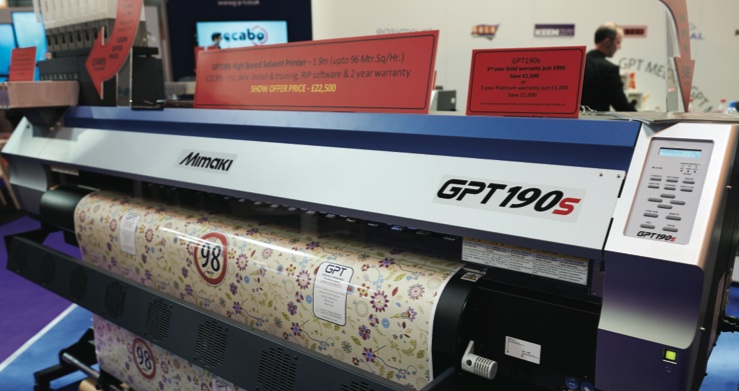Nessan Cleary gets to grips with this Mimaki TS34-1800adaptation.
This month’s Machine Matters covers a roll-to-roll solvent printer from Graphic Printing Technologies (GPT), a division of Amari Plastics that is perhaps best known as a reseller of printers from the likes of Mimaki, Epson and Agfa.
But GPT has also developed its own solvent printer, the 1.9m wide 190s, by taking the simple but effective approach of adapting proven Mimaki technology. In this case, GPT has used a Mimaki TS34-1800 dye sublimation printer and added a heater unit to adapt it for running solvent inks. It’s a smart solution that has all the robustness that one would expect of a Mimaki printer.
One reason why GPT chose this particular printer was that it’s built on a proven JV33 chassis. Another advantage was that it uses two Epson DX6 printheads, which could be adapted to run the full solvent ink at higher speeds. Rob Kaziewicz, technical manager at GPT, says that the heads and ink systems are largely unchanged with most of the work being to the electronics: “We are just modifying its brain to think that it’s a solvent machine.”
The most obvious difference is that GPT has added a heater to the front to cure the solvent inks, and integrated the control panel for the heater into the machine, tapping directly into the main board logic circuit. It’s a neat job and certainly doesn’t look like an aftermarket addition.
The result is a fast, relatively affordable solvent printer, though the actual productivity depends on the application and the Rip.
The printer is sold with a Mimaki RasterLink Rip and this is capable of producing good quality saleable results at a respectable rate of 38m2/hr, with a resolution of 720 x 540dpi in four-pass mode. Its highest quality mode is 720 x 1440dpi, which runs at 15m2/hr and is suitable for good quality vinyl production. However, the printer can also run at 98m2/hr at a resolution of 360 x 360dpi, which would be adequate for some banner work. But to reach this speed you need to upgrade to a Wasatch Rip.
Kaziewicz explains: “We run a different dither pattern with more half tone screening using less ink and hiding any artefacts.” In theory you could also use the Onyx and Shiraz Rips, but GPT has only tested the Wasatch Rip, since RasterLink is itself based on this.
The printer runs a standard CMYK inkset, but rather than the water-based dye sub inks of the original TS34, GPT has used Mimaki's own SS21 full organic solvent inks, which Kaziewicz says are classed as an irritant rather than as being harmful to the environment. Nonetheless, GPT has added a PureX extraction system to deal with the solvent smell and any build up of unwanted chemicals.
GPT has opted for full solvent, rather than organic solvent, because these inks cure faster leading to higher throughput. Full solvent inks also work with a wider range of cheaper materials, and give a very good finish.
The machine is mainly targeted at high volume users, with the main alternative being Roland’s new SolJet Pro4 XF-640 (AKA The Beast) and of course Mimaki’s own JV33 and JV5.
The GPT 190s costs £22,495 with a two-year warranty, or £23,995 with a three-year warranty. GPT provides support for the heaters with Hybrid Services, which is Mimaki’s UK distributor, covering the warranty for the Mimaki-built part of the machine. There's a bulk ink option, which is standard Mimaki and which GPT expects most customers to opt for. There's also a heavy-duty winder and rewinder system.
Strangely, many of the visitors who saw it at the Sign and Digital show earlier this year asked about a 1.3m wide version, which GPT is now considering though this is unlikely to cost much less because of the level of modification needed.


